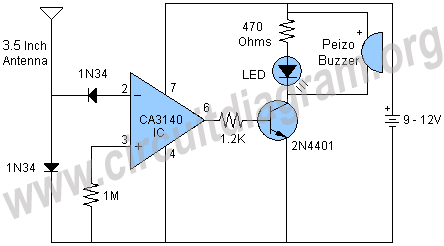000SHREDDER000
Full Member level 1
Hi guys I am alvin new here, can someone help to me to solve this circuit problem? I found this schematics on circuitdiagram website after building it many time it doesn't work correctly, circuit designer claims this circuit can detect cellphone waves from long distance but when I test it I didn't saw any detection
led is always on
I tried to make different designs with same components but none of them worked
some designs only detect human body!!! from near distance,
so what do you think about this circuit and how can I fix it? tank you:thinker:
Here is schematic:

[found at http://www.circuitdiagram.org/long-range-cell-phone-detector.html ]
led is always on
I tried to make different designs with same components but none of them worked
some designs only detect human body!!! from near distance,
so what do you think about this circuit and how can I fix it? tank you:thinker:
Here is schematic:

[found at http://www.circuitdiagram.org/long-range-cell-phone-detector.html ]
Last edited by a moderator:
